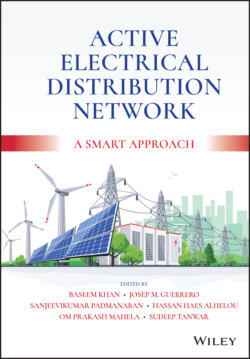Читать книгу Active Electrical Distribution Network - Группа авторов - Страница 46
2.5 Threats with Feeder Segregation and Possible Solutions
ОглавлениеThe basic objective behind this chapter is to discuss a theft handling mechanism for protecting various power equipment/appliances fitted in agricultural feeders during off-feed hours. This theft handling mechanism is based on a network reconfiguration in which the normal topological structure of the distribution feeder is changed to a new objective-based structure through closing and opening of the sectionalizing and tie switches. If the agricultural feeder is included as part of the feeder reconfiguration, electricity will be made available during off-feed hours, and hence thieves will not take any risk. The following broad steps are required to be taken when developing the theft handling mechanism:
Step 1: To develop a method to decide the locations of different sectionalizing and tie switches in such a way that the inclusion of some of the section of the agricultural feeder in the network reconfiguration will not energize the connected pumps.
Step 2: To develop a method for the selection of tapping points for the agricultural pumps in such a way that the pumps do not draw power during off-feed hours.
Step 3: To deduce the best suitable method for network reconfiguration based on the contemporary situation and the demand for the Feeder Segregation Plan.
Step 4: To draw up a plan for distribution system automation (DSA) to manage the network reconfiguration.
Step 5: To determine the optimal switching frequency for the network reconfiguration while considering all its dynamics and impacts.
Step 6: To validate the above proposed methodologies using high-end tools like ETAP/MATLAB.
Wherever the distribution system in not automated and switching is done manually, the positions of the tie switches are provided based on the ease of reachability and in India where the same practice is being adopted. However, wherever the distribution system is automated and there is scope for implementing network reconfiguration, placing the switches randomly will not serve the purpose. Hence technical studies are being carried out in deciding their numbers and positions. Many research publications are available in this context. As far as steps 1 and 2 are concerned, they are totally new concepts and hence no research is available in this area.
Developing the automation features for the distribution system operation involving an agriculture feeder in a network reconfiguration will totally depend upon the methodologies used for achieving steps 1 and 2. Hence, unless and until some methodology has been developed for steps 1 and 2, it is worthless to design a method for distribution system automation (DSA) considering a feeder reconfiguration. A number of automation models are available for the distribution system. Adequate technologies have been developed in the area of distribution system automation. The main components used for distribution system automation (DSA) are remote terminal units (RTUs), pole top units (P-RTUs), distribution control center (DCC), distribution automation software, communication network, IT network, etc. Simply by changing the operational strategy in an existing distribution system automation model, the task of network reconfiguration based on the set objectives can be achieved. Hence, designing the methodology for achieving step 4 can easily be done.
Switching is one of the important phenomenon in network reconfiguration. Network switching can be done as an hourly, daily, weekly, monthly, or seasonal reconfiguration plan, based on the load curves. Wherever the distribution system in not automated and switching is done manually, frequent switching operations are not possible. Under such a situation, constant load models (peak or mean value) are used for network reconfiguration related studies. However, wherever the distribution system is automated, dynamic (real-time) network reconfiguration is possible with the use of automatic (or remote controlled) switches. The flow chart presented in Figure 2.1 will explain the methodology for deducing the optimal switching frequency [37].
Figure 2.1 Methodology for deducing the optimal switching frequency.
The most important task required for the proposed mechanism is network reconfiguration. The next section describes the various tasks required, their methodology, and the various processes for implementation of the mechanism.
